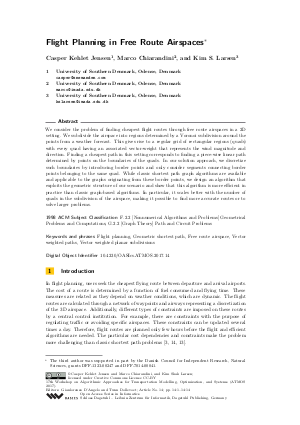Flight Planning in Free Route Airspaces
Authors Casper Kehlet Jensen, Marco Chiarandini, Kim S. Larsen
-
Part of:
Volume:
17th Workshop on Algorithmic Approaches for Transportation Modelling, Optimization, and Systems (ATMOS 2017)
Part of: Series: Open Access Series in Informatics (OASIcs)
Part of: Conference: Symposium on Algorithmic Approaches for Transportation Modelling, Optimization, and Systems (ATMOS) - License:
 Creative Commons Attribution 3.0 Unported license
Creative Commons Attribution 3.0 Unported license
- Publication Date: 2017-09-04
File

PDF
OASIcs.ATMOS.2017.14.pdf
- Filesize: 1.42 MB
- 14 pages
Document Identifiers
Subject Classification
Keywords
- Flight planning
- Geometric shortest path
- Free route airspace
- Vector weighted paths
- Vector weighted planar subdivisions
Metrics
- Access Statistics
-
Total Accesses (updated on a weekly basis)
0PDF Downloads0Metadata Views
Abstract
We consider the problem of finding cheapest flight routes through free route airspaces in a 2D setting. We subdivide the airspace into regions determined by a Voronoi subdivision around the points from a weather forecast. This gives rise to a regular grid of rectangular regions (quads) with every quad having an associated vector-weight that represents the wind magnitude and direction. Finding a cheapest path in this setting corresponds to finding a piece-wise linear path determined by points on the boundaries of the quads. In our solution approach, we discretize such boundaries by introducing border points and only consider segments connecting border points belonging to the same quad. While classic shortest path graph algorithms are available and applicable to the graphs originating from these border points, we design an algorithm that exploits the geometric structure of our scenario and show that this algorithm is more efficient in practice than classic graph-based algorithms. In particular, it scales better with the number of quads in the subdivision of the airspace, making it possible to find more accurate routes or to solve larger problems.
Cite As Get BibTex
Casper Kehlet Jensen, Marco Chiarandini, and Kim S. Larsen. Flight Planning in Free Route Airspaces. In 17th Workshop on Algorithmic Approaches for Transportation Modelling, Optimization, and Systems (ATMOS 2017). Open Access Series in Informatics (OASIcs), Volume 59, pp. 14:1-14:14, Schloss Dagstuhl – Leibniz-Zentrum für Informatik (2017)
https://doi.org/10.4230/OASIcs.ATMOS.2017.14
BibTex
@InProceedings{jensen_et_al:OASIcs.ATMOS.2017.14,
author = {Jensen, Casper Kehlet and Chiarandini, Marco and Larsen, Kim S.},
title = {{Flight Planning in Free Route Airspaces}},
booktitle = {17th Workshop on Algorithmic Approaches for Transportation Modelling, Optimization, and Systems (ATMOS 2017)},
pages = {14:1--14:14},
series = {Open Access Series in Informatics (OASIcs)},
ISBN = {978-3-95977-042-2},
ISSN = {2190-6807},
year = {2017},
volume = {59},
editor = {D'Angelo, Gianlorenzo and Dollevoet, Twan},
publisher = {Schloss Dagstuhl -- Leibniz-Zentrum f{\"u}r Informatik},
address = {Dagstuhl, Germany},
URL = {https://drops.dagstuhl.de/entities/document/10.4230/OASIcs.ATMOS.2017.14},
URN = {urn:nbn:de:0030-drops-79047},
doi = {10.4230/OASIcs.ATMOS.2017.14},
annote = {Keywords: Flight planning, Geometric shortest path, Free route airspace, Vector weighted paths, Vector weighted planar subdivisions}
}
Author Details
References
-
Lyudmil Aleksandrov, Anil Maheshwari, and Jörg-Rüdiger Sack. Approximation algorithms for geometric shortest path problems. In 32nd Annual ACM Symposium on Theory of Computing (STOC), pages 286-295, 2000.

-
Steve Altus. Effective flight plans can help airlines economize. AERO, 35, 2009.

- Marco Blanco, Ralf Borndörfer, Nam-Dung Hoang, Anton Kaier, Adam Schienle, Thomas Schlechte, and Swen Schlobach. Solving Time Dependent Shortest Path Problems on Airway Networks Using Super-Optimal Wind. In 16th Workshop on Algorithmic Approaches for Transportation Modelling, Optimization, and Systems (ATMOS 2016), volume 54 of OpenAccess Series in Informatics (OASIcs), pages 12:1-12:15. Schloss Dagstuhl - Leibniz-Zentrum für Informatik, 2016. URL: http://dx.doi.org/10.4230/OASIcs.ATMOS.2016.12.
-
John Canny and John Reif. New lower bound techniques for robot motion planning problems. In 28th IEEE Annual Symposium on Foundations of Computer Science (FOCS), pages 49-60, 1987.

-
Danny Z. Chen. Efficient algorithms for geometric shortest path query problems. In Handbook of Combinatorial Optimization, pages 1125-1154. Springer, 2013.

-
Danny Z. Chen, Robert J. Szczerba, and John J. Uhran. A framed-quadtree approach for determining Euclidean shortest paths in a 2-D environment. IEEE Transactions on Robotics and Automation, 13(5):668-681, 1997.

-
Thomas H. Cormen, Charles E. Leiserson, Ronald L. Rivest, and Clifford Stein. Introduction to Algorithms. MIT Press, 3rd edition, 2009.

-
Mark de Berg, Otfried Cheong, Marc van Kreveld, and Mark Overmars. Computational Geometry: Algorithms and Applications. Springer, 2008.

- Eurocontrol. Free route airspace (FRA). http://www.eurocontrol.int/articles/free-route-airspace. Accessed: 2017-03-28.
-
Michael L. Fredman and Robert Endre Tarjan. Fibonacci heaps and their uses in improved network optimization algorithms. Journal of the ACM, 34(3):596-615, 1987.

- Andrew Freedman. Planes flew from New York to London at near-supersonic speeds due to powerhouse jet stream. Mashable, 9 Jan 2015. http://mashable.com/2015/01/08/jet-stream-new-york-london-flights/ Accessed: 2017-05-30.
-
Jongrae Kim and João Hespanha. Discrete approximations to continuous shortest-path: Application to minimum-risk path planning for groups of UAVs. In 42nd IEEE Conference on Decision and Control (CDC), pages 1734-1740, 2003.

-
Anders N. Knudsen, Marco Chiarandini, and Kim S. Larsen. Constraint handling in flight planning. In 23nd International Conference on Principles and Practice of Constraint Programming (CP), Lecture Notes in Computer Science. Springer, 2017. To appear.

- Anders Nicolai Knudsen, Marco Chiarandini, and Kim S. Larsen. Vertical optimization of resource dependent flight paths. In 22nd European Conference on Artificial Intelligence (ECAI), pages 639-645, 2016. URL: http://dx.doi.org/10.3233/978-1-61499-672-9-639.
-
Joseph S. B. Mitchell and Christos H. Papadimitriou. The weighted region problem: Finding shortest paths through a weighted planar subdivision. Journal of the ACM, 38(1):18-73, 1991.

-
Robert J. Szczerba, Danny Z. Chen, and John J. Uhran. Planning shortest paths among 2D and 3D weighted regions using framed-subspaces. The International Journal of Robotics Research, 17(5):531-546, 1998.

- WAFC Washington. The world area forecast system (WAFS) internet file service (WIFS) users guide. https://www.aviationweather.gov/wifs/docs/WIFS_Users_Guide_v4.1.pdf. Accessed: 2017-05-30.
